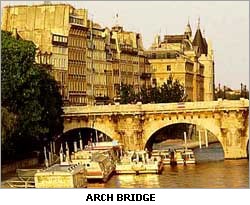DK Science & Technology: Construction
From houses and skyscrapers to bridges and highways, our environment is constructed from many different materials. Architects design structures to look good and fulfill a purpose—ENGINEERS make structures work.
An architect’s job is to design and plan new buildings and structures. Architects must consider the building’s use, the choice of materials, and the building’s environment. Plans show the exact position and construction of every detail, even the electric sockets.
Most large structures are built with concrete and steel. Concrete is used in huge quantities to make solid foundations. Concrete walls, columns, and arches are reinforced with steel to make them stronger. Wood is still used for many smaller buildings, particularly in MODULAR CONSTRUCTION. It is light yet tough.
The first stage is planning. The route must not destroy important landscapes or buildings. The design depends on the terrain the road crosses. Tunnels are needed through hills, and bridges across rivers. The site is cleared, foundations are dug, and a stable stone base is laid. The road is paved with concrete or asphalt.
Large parts of modern buildings can be built away from the site, then delivered for assembly. The modules fit together in a preplanned way. Modular construction reduces construction costs and the time spent at a construction site.
As well as the foundations, walls, and roof, the parts or systems that go into making a building include the heating, lighting, plumbing, and ventilation systems. Usually, these systems are installed when the main structure is complete, but some modules arrive with bathrooms and electrical wiring intact.
An engineer applies the principles of science to the design of structures and machines. Structural engineers, for example, make calculations to predict the stability of structures. Civil engineers plan the construction of railroads, roads, and dams.
A straight beam bends in the middle as it supports a load. A beam bridge can carry a load over a narrow gap, but a longer bridge needs a stronger shape. An arch supports the load from beneath—it directs the force around the curve to push against the ground at both sides. A suspension bridge supports a load from above, with cables.
The twin Petronas Towers in Kuala Lumpur, Malaysia, are the tallest skyscrapers in the world, at 1,482 ft (452 m) high. Engineers could build even taller structures, but higher buildings cost more money and need to be made safe.
A dam holds back water in a river to form an artificial lake. Water pressure increases with depth, so the greatest pressure on the dam is at its base—the dam wall is much thicker at the bottom than at the top.
Tunnels are cut with tunnel boring machines (TBMs), burrowing through the ground. As their cutting blades turn, the machines move forward at an average rate of about 1 mph (1.6 km/h). Engineers line the tunnel behind the TBMs with reinforced concrete rings to prevent the roof and walls from collapsing.

